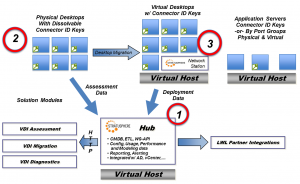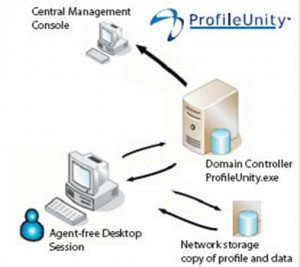This post is also available in: Italian
Reading Time: 5 minutesFounded in Atlanta in 2009, Liquidware Labs is one of leader in desktop transformation solutions for next-generation physical and virtual desktops, including VMware View, Citrix XenDesktop, and Microsoft Windows 7. Now it has offices also in Chicago, Vich (CH), Surrey (UK).
The Liquidware Labs executive team is comprised of veteran technologists and experts with hands-on knowledge of virtualized environments and solutions (most of them are from VizionCore, Quest, PHDVirtual, …). Because of their decades of combined software solutions experience and depth-of-expertise in virtualization and thin technologies, our management is constantly asked to provide their perspective on trends, and speak at virtualization events around the world.
Their solutions (Stratusphere™ and ProfileUnity™) have been described by analysts as the industry’s first ‘On-Ramp to VDI,’ providing a complete methodology and software that enables organizations to decouple users and applications from the operating system and to cost-effectively assess, design, migrate, and validate the user experience for next-generation desktop infrastructure.
Note that both have a single management server, delivered as a virtual appliance and available (on the download page) in different format (XVA, VHD, OVF), for the different type of hypervisor (a good example of multi-platform ecosystem).
Stratusphere
This solution is a stack for several products:
- Stratusphere FIT: for the inizial assessment.
- Stratusphere UX: to monitor, compare and verify the Service Level (can monitor both physical and virtual machine).
- Stratusphere IxD (not yet available): to assist and help in design of a VDI environment (using the data from FIT).
 The architecture is based of different elements:
The architecture is based of different elements:
- Hub: is the virtual appliance available from the download site and is the management station for all products.
- Connector ID Keys (CID): the “agent” installed on physical and virtual desktops (available both for Windows and Linux).
- Network station: a virtual appliance (one for each virtualization host) to monitor the virtual infrastructure.
All virtual appliance are Linux based and it’s really interesting that it’s included also an embedded database (PostgresQL), and also external database servers could be used.
Also is really interesting that it can correlate into a single pane glass different metrics to have a multi-dimension analytics: main parameters are machines, end users and applications.
Compared to VMware Capacity Planner for View (but also other similar tools), FIT has the big advantages to use an internal engine (so no data goes outside the company), to permit the self-removable of the “agent”, to provide capacity estimation NOT only for a VMware View environment, but also for Citrix XenDestop, Microsoft and RedHat. Also it can provide several type of reports (some example are available on the web site), included useful information about the storage part.
Maybe a possible limit is that it only analyze the VDI case, but for some kind of users and/or applications maybe a different virtualization approach (like session virtualization or application virtualization) could be a better choice. Could be interesting see if the IxD module will assist also in the design of a geographic architecture and the storage part, in this case it could become a must.
The UX part can monitor the complete environment from the endpoint, to the network, the connection broker, the servers, hosts and the storage, included the cloud and the user settings, applications and user state portability! Note that exist also a Stratusphere Adapter for vCenter Ops to integrate the UX part inside a single management interface.
One of the interesting aspect of UX is that it can provide data also during the initial assestement, so you can compare the user experience before and after the migration!
ProfileUnity
Manage user environment and application settings portability and transition, by isolating and separating the OS from the user part. ProfileUnity separates personalization (profiles and data) and desktop configuration (settings, etc) from the Windows OS. Profiles and Configurations are stored locally and on the network. And with the FlexApp add-on can also manage application deployment.
Compare to tool only limited to the user profile manament (like for example VMware Persona Management or the Microsoft Roaming Profile) this is more flexible and can handle both virtual and physical enviroment and also different type of Windows OS: all with a single “profile” for each user!
 The architecture is quite interesting because it does not rely on AD GPO, but mainly on scripts (one for the machine startup and one for the user logoff). Sounds like an old approach, but in this case could be more flexible (and I suppose that could work also on a Samba domain). Scripts are quite small and storade on the netlog shared folder of a AD DC (by default this share is automatically replicated an all DCs), but other shared folders could be used.
The architecture is quite interesting because it does not rely on AD GPO, but mainly on scripts (one for the machine startup and one for the user logoff). Sounds like an old approach, but in this case could be more flexible (and I suppose that could work also on a Samba domain). Scripts are quite small and storade on the netlog shared folder of a AD DC (by default this share is automatically replicated an all DCs), but other shared folders could be used.
Some part on how it can hadle the OS migration are still not clear for me, it can handle renaming or path changes of some folders, but how can really handle the diffent user registry part? Some keys are not compatible across OSe.
FlexApp
FlexApp technology allows admins to deploy user and corporate department applications to users, groups, departments, or the entire enterprise, without affecting the underlying base image of virtual machines. Currently for use with non-persistent virtual desktops, FlexApp leverages flexible VHD to store the needed files for each application. Applications look native to the OS, enabling compatibility of thousands of more apps than traditional application virtualization. Complex applications that require file system drivers and an intimate relationship with the OS or other applications install flawlessly. ProfileUnity then inserts one-to-one corresponding links into the OS within seconds at login to restore assigned applications for each user.


